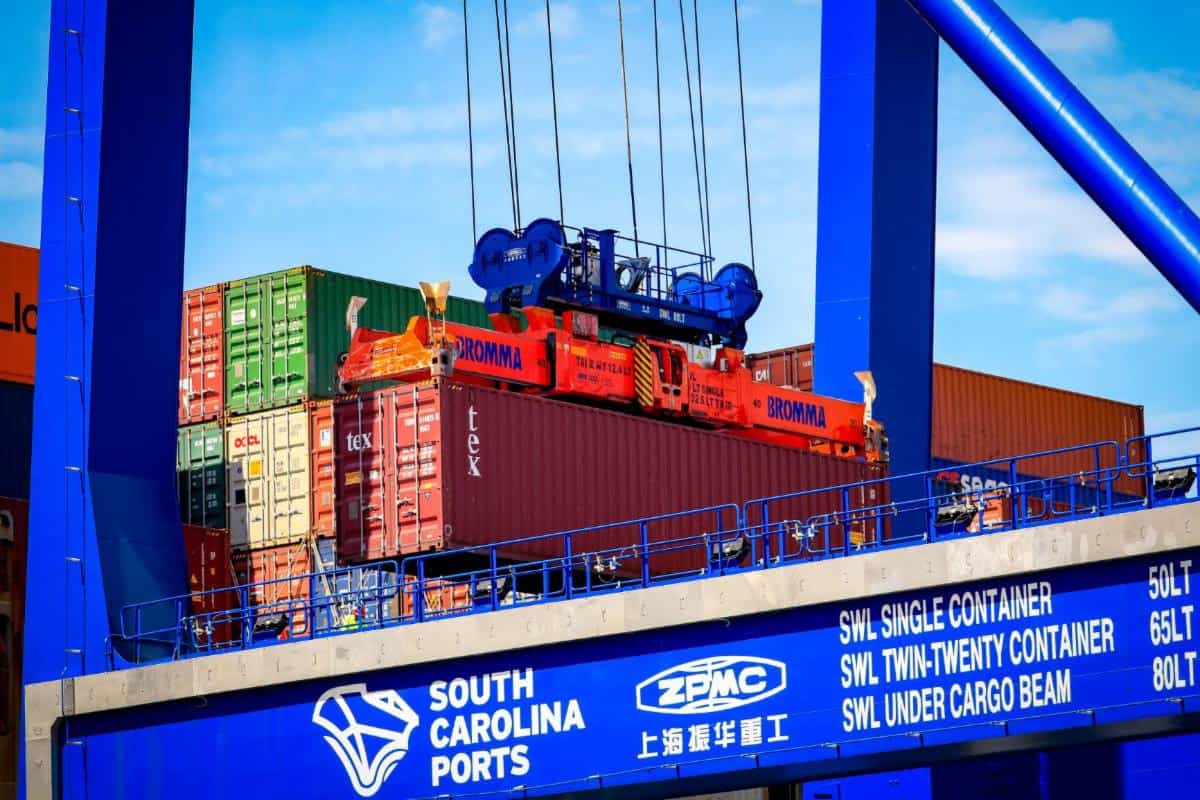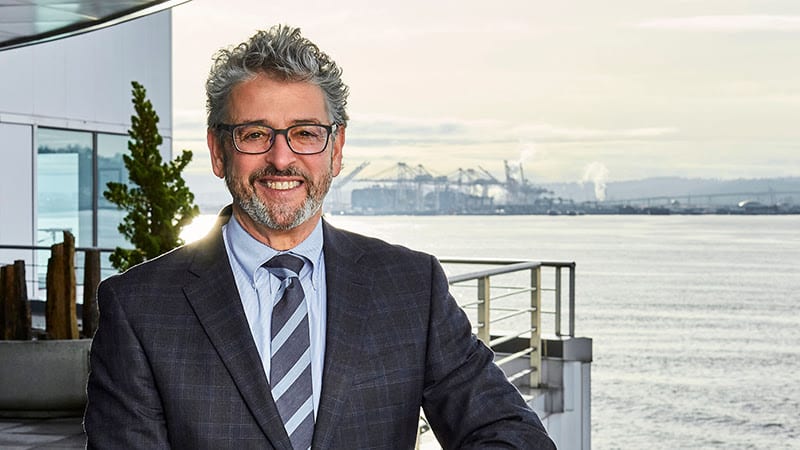The Jacksonville Port Authority (JAXPORT) reported Monday that contractors have completed the latest phase in $104 million of berth enhancements at the SSA Jacksonville Container Terminal at Blount Island.
This provides an additional 700 linear feet of newly rebuilt deepwater berthing space at the Jacksonville, Florida, facility. The reconstruction of the container terminal is a public-private partnership between JAXPORT and SSA Atlantic.
Completion of the final phase of the project, another 700 linear feet, will coincide with the end of harbor deepening in 2022, JAXPORT said.
Upon completion of the berth enhancements, the facility will feature two newly reconstructed 1,200-foot-long container berths capable of simultaneously accommodating two post-Panamax vessels. The berths are electrified to handle a total of 10 state-of-the-art, environmentally friendly, electric-powered, 100-gauge container cranes, including three currently in use.
More than $72 million in phased yard improvements are underway to enable the SSA Jacksonville Container Terminal to accommodate up to 700,000 twenty-foot equivalent units (TEUs) annually.
The federal project to deepen the Jacksonville shipping channel to a depth of 47 feet from its current 40 feet is fully funded through Blount Island, with the anticipated completion in 2022 three years ahead of the original schedule. A new vessel-turning basin that will allow larger vessels to turn at Blount Island berths is on track to be completed by the end of this year.

South Carolina Ports Authority
The South Carolina Ports Authority said it has significantly updated its fiscal year 2021 forecast following several months of strong volumes and a continued rebound.
The updated plan projects that South Carolina Ports will handle 1.38 million pier containers in fiscal year 2021, ending June 30. This is up from the original projection of 1.23 million pier containers and, if achieved, would surpass the fiscal year 2019 volume record of 1.36 million pier containers handled.
The revised forecast also projects the port handling 243,595 vehicles and a combined total of 176,073 rail moves at inland ports in fiscal year 2021.
“Several months of much higher-than-expected volumes at SC Ports, including a record November and December, propelled this updated forecast,” the announcement said. “SC Ports has seen month-over-month strength across multiple business segments since September, including with containers, vehicles and inland ports.”
The ports authority board also has approved two staff promotions to managerial positions, effective next Monday.
Paul McClintock will serve as the senior vice president of export projects. McClintock, who joined SC Ports in 2009, has been the senior vice president of marketing and sales.
Micah Mallace will move into the position McClintock is vacating. Mallace joined SC Ports in 2011 and most recently served as director of national Accounts.

Port of Seattle
The Port of Seattle Commission has elected Fred Felleman as commission president for 2021.
Commissioner Ryan Calkins will serve as vice president and Commissioner Sam Cho will serve a second term as secretary.
“This has been an exceptionally challenging year punctuated by a health and economic crisis as well as the ongoing social justice crisis which spotlighted how threadbare our economic fabric is for many communities. Key to addressing these inequities will be the creation of living wage jobs through innovation and workforce development, Felleman said.
“Opportunities will grow at the airport and seaport as the international arrivals facility, north satellite and Terminal 5 come online and others get underway in 2021,” he continued. We will also maintain our commitment to reducing our carbon footprint by developing sustainable aviation fuels and waterfront electrification. Now more than ever, we are poised to build back better by fostering innovations that create the green jobs of the future.”
In 2021, the Northwest Seaport Alliance, the joint venture of the ports of Seattle and Tacoma that operates international cargo facilities in both harbors, will open the first phase of its modernized Terminal 5 in West Seattle.
Felleman recently announced that the Port of Seattle had won the Washington Public Ports Association Environmental Stewardship Award for an initiative to reduce shipping noise called Quiet Sound. The program also is designed to help protect endangered orcas.
“Ultimately the success of the Quiet Sound program requires getting timely and reliable sighting information to the Puget Sound Pilots, ferry and tugboat captains, the Coast Guard and Marine Exchange if we are to broadly operationalize the recommendations of the program,” Felleman said. “I’m also committed to helping integrate a Quiet Sound-like program into the Coast Guard’s robust vessel traffic system (VTS). We are fortunate to have the only international VTS in the country and the Canadian Coast Guard has just established a ‘whale desk’ in its operations center.”
Port of Long Beach
The Federal Reserve Bank of San Francisco has appointed Port of Long Beach Executive Director Mario Cordero to its Los Angeles branch board of directors.
Cordero has led the Port of Long Beach since 2017.
“I look forward to serving in this capacity, especially as we all work to help the economy recover,” Cordero said in a statement.
Prior to becoming the port’s executive director, Cordero served on the Federal Maritime Commission from 2011 to 2017 and was FMC chairman from April 2013 to January 2017. Cordero, an attorney, served as a Long Beach harbor commissioner from 2003 to 2011.
The Federal Reserve Act of 1913 requires each of the nation’s 12 Reserve Banks to operate under the supervision of a board of directors. In the case of the Federal Reserve Bank of San Francisco, its four branches in LA, Portland, Oregon, Salt Lake City and Seattle each have a separate seven-member branch board.
Port of Duluth-Superior
Like other American ports across the Great Lakes, the Port of Duluth-Superior witnessed an increase in wind cargo arrivals in the recently completed shipping season, as well as a boost in agricultural exports. The grain gains were modest in Duluth-Superior — tracking 1% to 2% ahead of the 2019 pace and the five-season average — but the wind cargo uptick was more pronounced, the port said.
“It was a record-setting season for wind energy cargoes in Duluth,” said Deb DeLuca, executive director of the Duluth Seaway Port Authority. “In fact, it was our second-consecutive record-setting season for that particular type of cargo.”
The Port of Duluth-Superior, located in Duluth, Minnesota, said it welcomed 30 oceangoing ships with wind cargoes in 2020, sailing from eight countries: Brazil, Germany, India, Malaysia, Mexico, South Korea, Spain and Turkey. These shipments included the longest blades (242 feet) and towers (100 feet) ever handled in Duluth. In total, the port received 525,000 freight tons of wind cargoes in 2020, easily eclipsing the 2019 mark of 306,000 freight tons. Collectively, the components will assemble 154 wind turbines across Minnesota, North Dakota and South Dakota.
“The fact that we were able to handle this record-setting volume of wind cargo this year didn’t happen by accident,” said DeLuca. “It’s a testament to years of hard work.”
“Being North America’s farthest-inland seaport really lends well to Duluth being the Midwest hub for wind cargo arrivals,” she said. “The fact that cargo can sail so far inland — some 2,038 nautical miles from the Atlantic Ocean to Duluth — is very advantageous for shippers.”
Port of Corpus Christi
Texas’ Port of Corpus Christi said it ended 2020 with record tonnage, mainly attributable to a 65% increase in crude oil shipments from 2019. The port set a new annual tonnage record of 159.7 million tons, a 31% increase over 2019, as well as a new monthly record of 15.9 million tons for December, 15% higher than December 2019.
This performance helped push fourth-quarter results to a quarterly record of 42.2 million tons, surpassing the prior record from Q1 2020, the port said.
The port also saw a 26% increase in liquefied natural gas shipments at 8.7 million tons, and agricultural exports increased 70% in 2020 to nearly 4.3 million tons. The port said it “further solidified its position as the nation’s leading energy export gateway with a record 1.9 million barrels per day of crude oil exports in December 2020.”
Once an improvement project is completed in late 2023, the Corpus Christi ship channel will be the deepest and widest in the U.S. Gulf. The project received an additional $100 million in federal appropriations in December as part of the Water Resources Development Act passage.
The Port of Corpus Christi also recently reported it was the first port authority in the world to complete a third consecutive year operating on 100% renewable energy.
The Texas port began charting its stewardship course in 2016 with the adoption of an environmental policy that committed to 100% renewable energy by 2018, a goal it achieved ahead of schedule. By 2020, the port claimed nearly 10 million kilowatt hours of green energy credits, making it the first port in the region to do so.
“When the port authority, with full support of the port commission, made the commitment to 100% renewable energy as a decarbonization strategy, it demonstrated our belief that economic prosperity can be achieved safely and responsibly. We welcome other seaports who have recently followed our example,” Sean Strawbridge, the port’s CEO, said in the announcement.
The port said it has recycled more than 1 million pounds of materials since 2005, is proactive with air monitoring and has recently used a federal grant to purchase a solar-powered floating skimmer to keep trash from flowing into Corpus Christi Bay during periods of heavy rainfall.
Port of South Louisiana
Linda Prudhomme, the Port of South Louisiana’s business development director, has retired after more than 19 years of service. Julia Fisher-Perrier has been promoted to the position.
“Linda’s extensive knowledge of existing Louisiana industry, expertise in target marketing and collaborative efforts with the local economic development community has helped the Port of South Louisiana produce significant results,” the port said. “She has been responsible for the implementation of the strategic plan for the Port of South Louisiana, which has facilitated the attraction of new industries or expansion of existing ones based upon synergies of strength of the port’s industrial base.
“In working with economic development allies within the port district, she was responsible for facilitating new foreign investments, such as Formosa, South Louisiana Methanol and Yuhuang Chemicals, amounting to $23.2 billion in capital investments and approximately 3,750 direct jobs for the tri-parish district,” the port said.
Among Piers: Port of Oakland ends 2020 on high note
Military vehicle imports help JAXPORT combat COVID-19 storm
South Carolina Ports continues riding volume wave
Click here for more American Shipper/FreightWaves stories by Senior Editor Kim Link-Wills.











